Transform your homemade soap into a rainbow of natural colors using seven powerful plant-based dyes. You'll create rich reds with madder root, golden yellows with turmeric, vibrant oranges with annatto seeds, blue-greens with spirulina, deep purples with alkanet root, true blues with indigo, and dramatic blacks with activated charcoal. These natural colorants not only provide stunning hues but also offer unique skincare benefits. Discover how each dye's properties can elevate your soap-making journey.
Madder Root: Creating Rich Red and Pink Tones
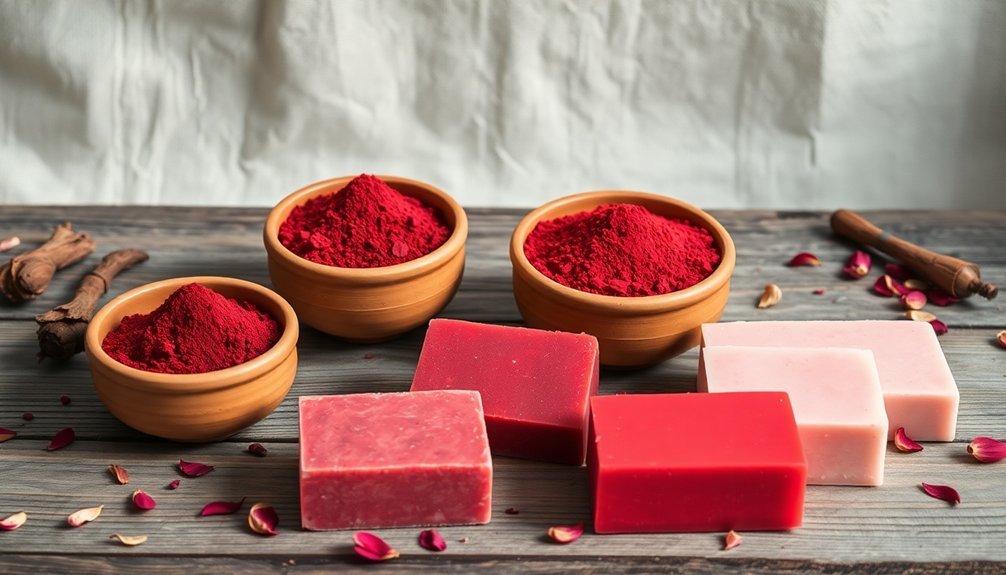
Nature's crimson paintbrush, madder root stands as a versatile plant-based dye for creating stunning red and pink tones in homemade soap.
You'll find that this natural colorant offers remarkable flexibility in achieving your desired shade, as the final color largely depends on your soap's pH level.
To create vibrant pinks, you'll want to incorporate madder root in an acidic environment, while neutral or alkaline conditions will yield deep red hues.
Start with 1 teaspoon of madder root powder per pound of oils to achieve noticeable color without overdoing it.
Since these natural colorants can fade with time and light exposure, you'll need to store your finished soaps properly to maintain their rich tones.
As a sustainable choice, madder root aligns perfectly with eco-conscious soap crafting practices.
Turmeric and Annatto Seeds for Golden Hues
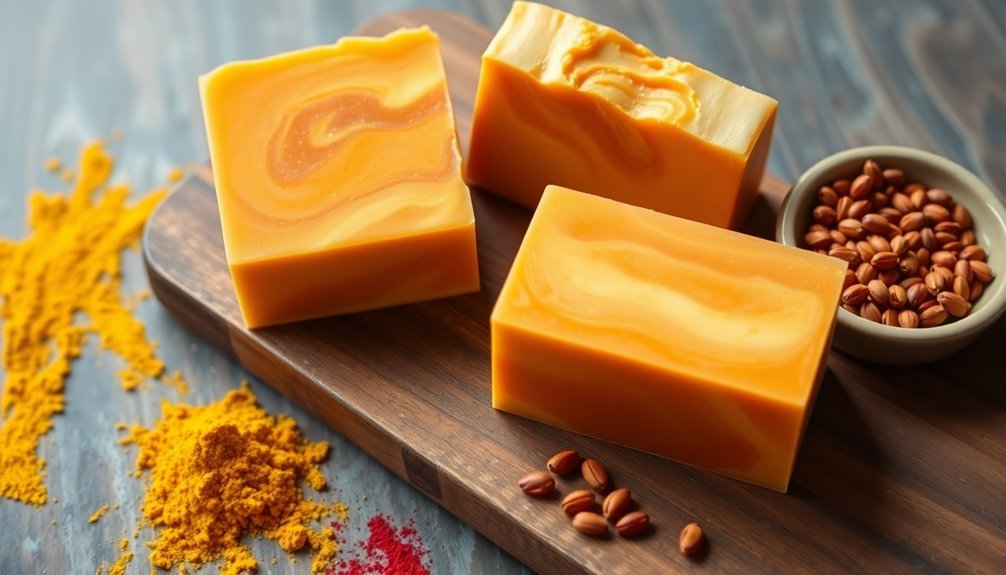
When seeking to create warm, sun-kissed tones in your handmade soaps, turmeric and annatto seeds offer remarkable natural coloring options.
You'll find turmeric delivers a vibrant yellow shade, while annatto seeds produce rich orange hues that'll make your soaps glow with natural warmth.
To achieve the best results with these natural colorants, you'll want to limit their usage to 5% of your total soap weight. This guarantees you'll get the perfect color intensity without affecting the soap's quality.
For the perfect balance of color and quality, keep natural dyes like turmeric and annatto at 5% of total soap weight.
Remember that both turmeric and annatto are plant-based dyes, making them safe for your skin and free from synthetic chemicals.
Since these natural pigments can fade or change over time, you'll need to store your finished soaps away from direct sunlight to maintain their beautiful golden tones.
Spirulina and Chlorella's Green Spectrum

You can create a range of green shades in your soap by choosing between spirulina's vibrant blue-green and chlorella's earthy tones.
For best results, mix your chosen algae powder directly into the oils during the soap-making process, ensuring even distribution throughout the batch.
Start with 1-2 teaspoons per pound of soap base, adjusting the amount until you achieve your desired green intensity, while remembering to store the finished products away from direct sunlight to preserve their color.
Natural Green Color Variations
The stunning green spectrum achieved through spirulina and chlorella offers soap makers two powerful natural alternatives to synthetic dyes. When you're looking to color your soap naturally, these plant colorants provide varying shades of green while adding beneficial properties to your creations.
You'll find that spirulina can be added to soap at 1-2 teaspoons per pound of oils, creating vibrant emerald tones packed with proteins and vitamins.
Chlorella, another excellent choice among natural soap colorants, delivers a slightly different green hue while contributing detoxifying properties. To attain the best results, you'll want to mix either powder with distilled water to form a smooth slurry before incorporating it into your soap mixture.
This technique prevents clumping and guarantees even color distribution throughout your final product.
Adding Powder To Oils
Successfully blending spirulina and chlorella powders into your soap begins with proper oil incorporation.
You'll want to mix these natural colorants with your base oils before adding the lye solution to prevent any clumping and guarantee smooth distribution throughout your batch.
For the best results, limit your colorant usage to 5% of your total soap weight.
In a 1-pound batch, that's no more than 0.8 ounces of powder. This ratio helps you achieve different shades of green while maintaining the soap's quality.
If you're using the cold-process soap making method, you'll typically get brighter, more vibrant results than with other techniques.
Remember to store your finished soaps away from direct sunlight to preserve their beautiful green hues and prevent color fading during the curing process.
Optimal Usage Rates
Mastering ideal usage rates for spirulina and chlorella starts with understanding their color spectrum potential.
You'll want to limit these natural colorants to 5% of your total soap recipe weight to achieve vibrant green hues without overwhelming your formulation.
When you're coloring soap with spirulina, start with small test batches to see how the pigments react in your specific recipe.
Different soap-making methods can affect the final color intensity – what works in cold process might differ in melt-and-pour.
You'll need to adjust accordingly based on your desired shade.
Remember to store your finished soaps away from direct sunlight to preserve their natural green color.
This careful attention to both usage rates and storage conditions will help you create consistently beautiful, plant-based soaps that maintain their vibrancy over time.
Purple Magic With Alkanet Root
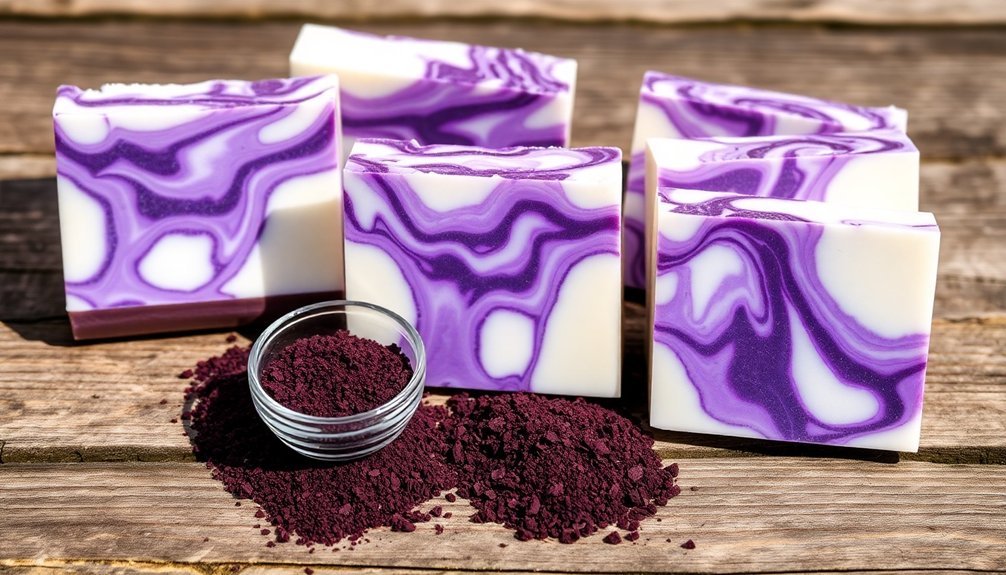
For stunning purple shades in your handmade soap, you'll find alkanet root to be a powerful natural colorant when used at up to 5% of your total soap weight.
To achieve the best results, create an oil infusion with the root before adding your lye solution, which prevents unwanted speckling and guarantees even color distribution.
Since the final shade can vary based on your soap's pH and may fade with light exposure, store your finished bars away from direct sunlight to preserve their beautiful purple hue.
Natural Purple Color Tips
Natural purple soap colors can be tricky to achieve, but alkanet root offers a reliable solution for creating beautiful violet and purple hues in your cold process soap.
To maximize your success with this natural colorant, you'll want to infuse alkanet root powder in your soap-making oils before adding it to your soap batter. This guarantees even color distribution throughout your bars.
Keep your alkanet root usage to 5% or less of your total soap weight for ideal results. Since this natural purple color can be sensitive to various factors, it's smart to test small batches first – the final shade might surprise you depending on your recipe's pH and oil choices.
Don't forget to cure and store your finished soap away from direct sunlight to preserve those vibrant purple hues you've worked to achieve.
Root Infusion Best Practices
Now that you understand the basics of alkanet root, let's focus on creating the perfect oil infusion – the key to revealing those coveted purple hues in your soap.
Start by selecting your preferred carrier oil, such as olive or coconut oil, and combine it with alkanet root powder at a ratio of 1 teaspoon per pound of oils.
Let the mixture steep until you achieve your desired hue. When making cold process soap, you'll want to add your infused oil at trace to guarantee even color distribution and prevent unwanted speckling in your final product.
Remember to store your finished soap in a cool, dark place, as alkanet-colored soaps can fade or change color when exposed to light.
Indigo Plant for Deep Blue Shades
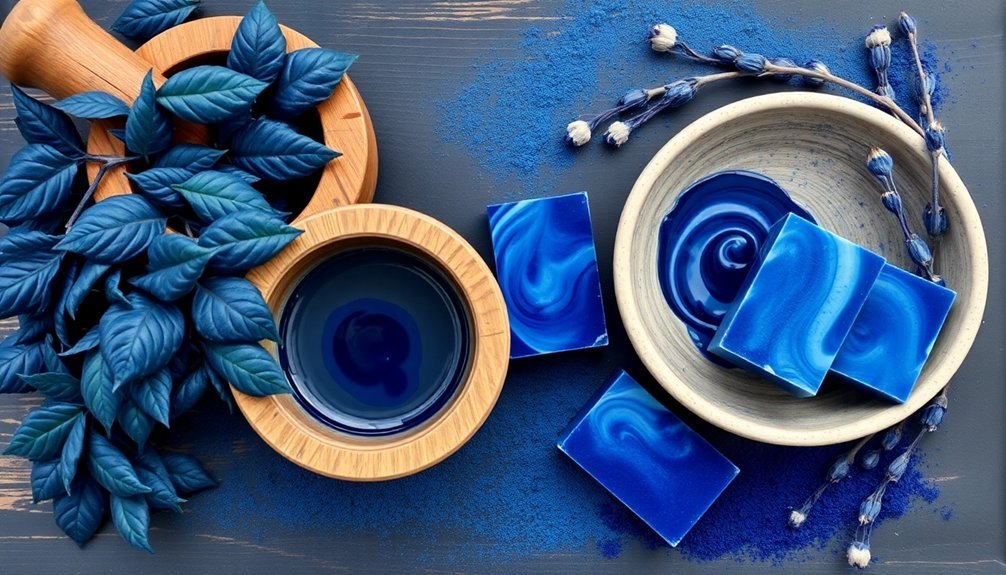
The majestic indigo plant (Indigofera tinctoria) stands as one of the most reliable sources for achieving deep blue shades in handcrafted soap.
This natural dye powerhouse lets you create stunning variations of blue in your soap-making process, from soft sky tints to rich ocean depths.
To successfully work with indigo in your soap:
- Create a slurry by mixing indigo powder with distilled water before adding it to your soap mixture
- Take advantage of soap's natural alkalinity to enhance the vibrancy of your blues
- Start with small amounts and adjust concentration to achieve your desired shade
- Store your finished soaps away from direct sunlight to prevent color fading
- Consider the pH level of your soap base, as it will affect the final color intensity
Earth-Toned Clay Varieties
Four distinct earth-toned clays offer soap makers a versatile palette of natural colorants while adding beneficial properties to their creations.
You'll find Kaolin Clay delivers a subtle, creamy finish and boasts a perfect 5-star rating from customers who love its gentle texture.
French Green Clay, another 5-star favorite, creates striking green hues that'll make your soaps stand out.
If you're looking for detoxifying properties, Sea Clay's earthy tones are an excellent choice, though its 3.5-star rating suggests varying results.
For budget-conscious crafters, Yellow Brazilian Clay presents an affordable option at $2.99, down from $5.99, and adds unique yellow tones to your soap.
These earth-toned clays not only color your soap naturally but also enhance its skincare benefits.
Activated Charcoal for Dramatic Black
Beyond earth-toned clays, activated charcoal offers soap makers a striking black colorant that commands attention.
You'll need only a small amount of distilled water to create a slurry before adding it to your soap at trace. For ideal results, use 1 gram per pound of soap base to achieve that perfect noir shade.
When working with colors in cold process soap making, here's what you need to know about activated charcoal:
- Creates a dramatic, true black hue
- Offers beneficial absorption properties for skincare
- Requires pre-mixing with distilled water for even distribution
- Works best when thoroughly incorporated at trace
- May stain light-colored washcloths or surfaces
Remember to handle your charcoal-colored soaps with care, as their rich pigmentation can transfer to lighter materials during use.
Frequently Asked Questions
How to Get Vibrant Colors in Soap?
You'll get vibrant soap colors by using 3 grams of dye per pound, mixing it into a slurry with distilled water first. Don't forget to insulate while curing to promote gelling and enhance vibrancy.
What Herbs Are Good for Coloring Soap?
You'll get beautiful reds from madder root, yellows from turmeric, purples from alkanet and gromwell roots, orange from annatto seeds, and greens from spirulina. Test small batches to guarantee your desired color intensity.
What Dye Can You Use for Soap?
You can use natural plant-based dyes like madder root for pink, turmeric for yellow, and annatto seeds for orange. Synthetic colorants also work well, but don't exceed 5% of your total soap weight.
What Is the Natural Purple Color for Soap Making?
You'll find that Alkanet root and Gromwell root are your best natural options for purple soap. They'll create beautiful purple shades when properly infused, but remember they shouldn't exceed 5% of your total soap weight.
In Summary
Now you're ready to create beautiful, naturally colored soaps using these seven plant-based dyes. Don't be afraid to experiment with different combinations and concentrations to achieve your desired shades. Remember to document your recipes and results, as natural colorants can vary in intensity. Whether you're making soap for personal use or as gifts, these botanical dyes will help you craft unique, chemical-free products that showcase nature's vibrant palette.

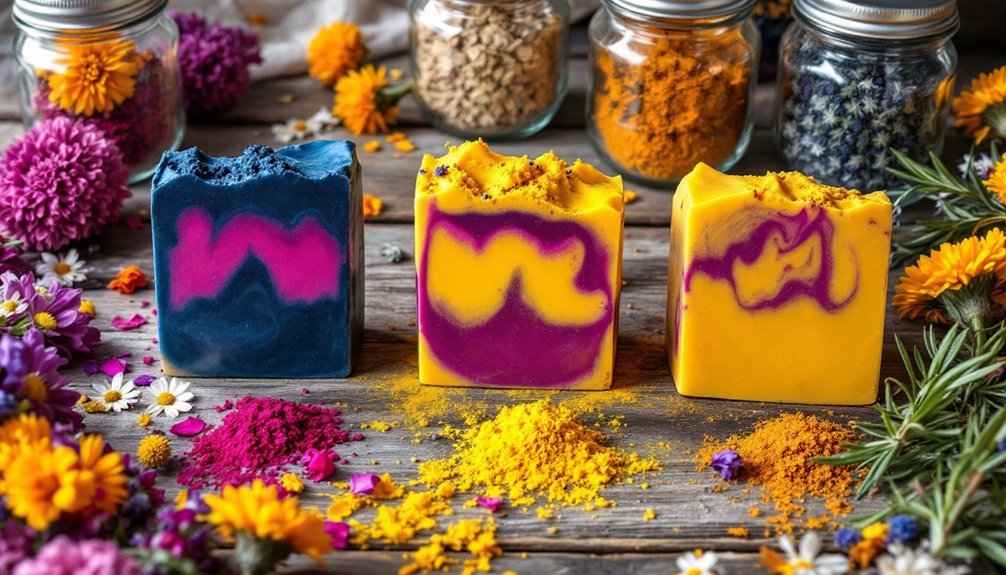



Leave a Reply